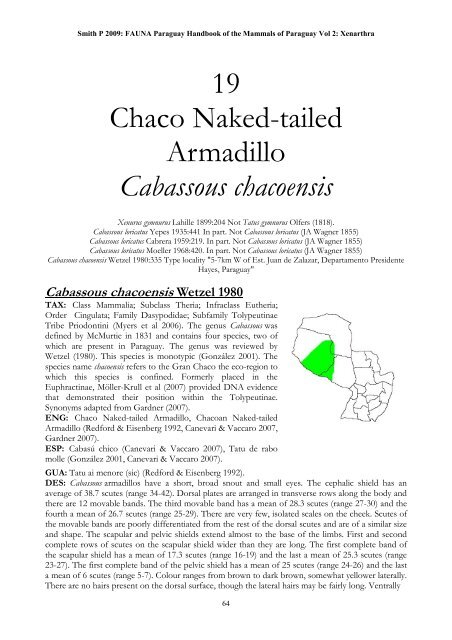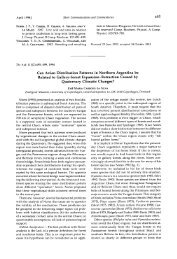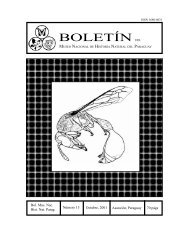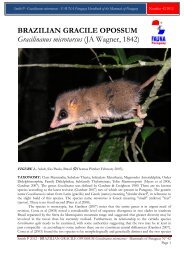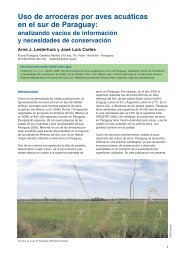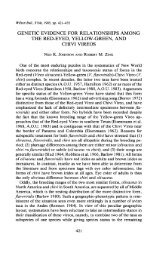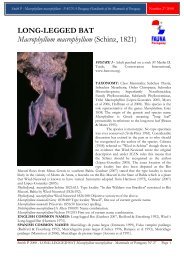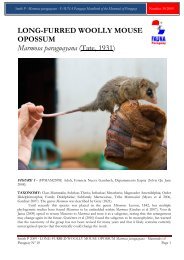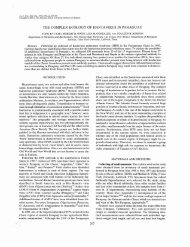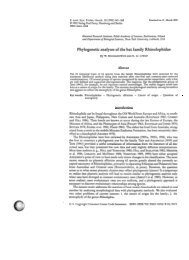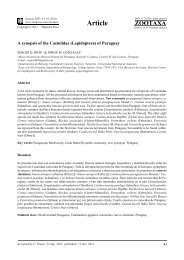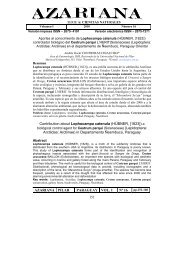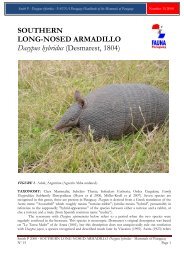hbk mammals vol 2 - FAUNA Paraguay
hbk mammals vol 2 - FAUNA Paraguay
hbk mammals vol 2 - FAUNA Paraguay
Create successful ePaper yourself
Turn your PDF publications into a flip-book with our unique Google optimized e-Paper software.
Smith P 2009: <strong>FAUNA</strong> <strong>Paraguay</strong> Handbook of the Mammals of <strong>Paraguay</strong> Vol 2: Xenarthra<br />
19<br />
Chaco Naked-tailed<br />
Armadillo<br />
Cabassous chacoensis<br />
Xenurus gymnurus Lahille 1899:204 Not Tatus gymnurus Olfers (1818).<br />
Cabassous loricatus Yepes 1935:441 In part. Not Cabassous loricatus (JA Wagner 1855)<br />
Cabassous loricatus Cabrera 1959:219. In part. Not Cabassous loricatus (JA Wagner 1855)<br />
Cabassous loricatus Moeller 1968:420. In part. Not Cabassous loricatus (JA Wagner 1855)<br />
Cabassous chacoensis Wetzel 1980:335 Type locality "5-7km W of Est. Juan de Zalazar, Departamento Presidente<br />
Hayes, <strong>Paraguay</strong>"<br />
Cabassous chacoensis Wetzel 1980<br />
TAX: Class Mammalia; Subclass Theria; Infraclass Eutheria;<br />
Order Cingulata; Family Dasypodidae; Subfamily Tolypeutinae<br />
Tribe Priodontini (Myers et al 2006). The genus Cabassous was<br />
defined by McMurtie in 1831 and contains four species, two of<br />
which are present in <strong>Paraguay</strong>. The genus was reviewed by<br />
Wetzel (1980). This species is monotypic (González 2001). The<br />
species name chacoensis refers to the Gran Chaco the eco-region to<br />
which this species is confined. Formerly placed in the<br />
Euphractinae, Möller-Krull et al (2007) provided DNA evidence<br />
that demonstrated their position within the Tolypeutinae.<br />
Synonyms adapted from Gardner (2007).<br />
ENG: Chaco Naked-tailed Armadillo, Chacoan Naked-tailed<br />
Armadillo (Redford & Eisenberg 1992, Canevari & Vaccaro 2007,<br />
Gardner 2007).<br />
ESP: Cabasú chico (Canevari & Vaccaro 2007), Tatu de rabo<br />
molle (González 2001, Canevari & Vaccaro 2007).<br />
GUA: Tatu ai menore (sic) (Redford & Eisenberg 1992).<br />
DES: Cabassous armadillos have a short, broad snout and small eyes. The cephalic shield has an<br />
average of 38.7 scutes (range 34-42). Dorsal plates are arranged in transverse rows along the body and<br />
there are 12 movable bands. The third movable band has a mean of 28.3 scutes (range 27-30) and the<br />
fourth a mean of 26.7 scutes (range 25-29). There are very few, isolated scales on the cheek. Scutes of<br />
the movable bands are poorly differentiated from the rest of the dorsal scutes and are of a similar size<br />
and shape. The scapular and pelvic shields extend almost to the base of the limbs. First and second<br />
complete rows of scutes on the scapular shield wider than they are long. The first complete band of<br />
the scapular shield has a mean of 17.3 scutes (range 16-19) and the last a mean of 25.3 scutes (range<br />
23-27). The first complete band of the pelvic shield has a mean of 25 scutes (range 24-26) and the last<br />
a mean of 6 scutes (range 5-7). Colour ranges from brown to dark brown, somewhat yellower laterally.<br />
There are no hairs present on the dorsal surface, though the lateral hairs may be fairly long. Ventrally<br />
64


